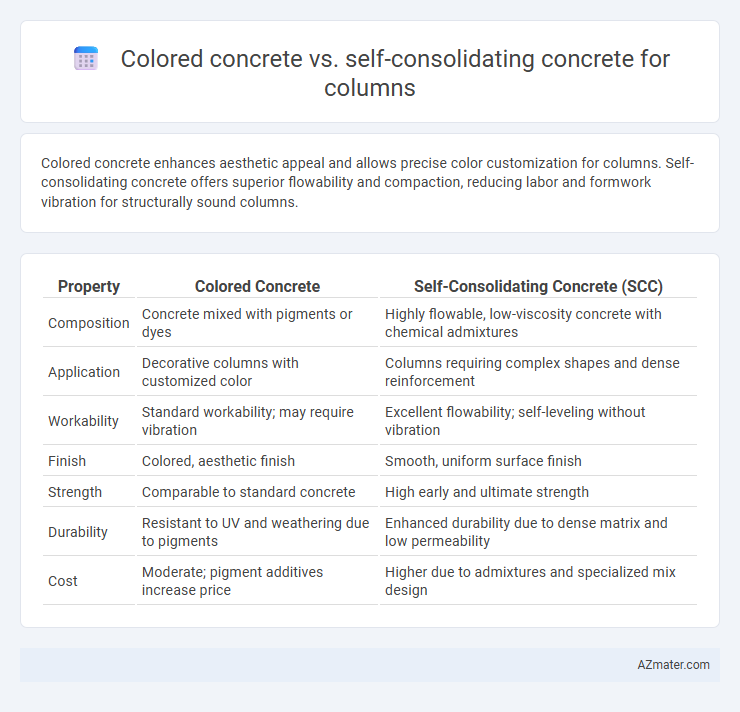Colored concrete enhances aesthetic appeal and allows precise color customization for columns. Self-consolidating concrete offers superior flowability and compaction, reducing labor and formwork vibration for structurally sound columns.
Table of Comparison
| Property | Colored Concrete | Self-Consolidating Concrete (SCC) |
|---|---|---|
| Composition | Concrete mixed with pigments or dyes | Highly flowable, low-viscosity concrete with chemical admixtures |
| Application | Decorative columns with customized color | Columns requiring complex shapes and dense reinforcement |
| Workability | Standard workability; may require vibration | Excellent flowability; self-leveling without vibration |
| Finish | Colored, aesthetic finish | Smooth, uniform surface finish |
| Strength | Comparable to standard concrete | High early and ultimate strength |
| Durability | Resistant to UV and weathering due to pigments | Enhanced durability due to dense matrix and low permeability |
| Cost | Moderate; pigment additives increase price | Higher due to admixtures and specialized mix design |
Introduction to Colored Concrete and Self-Consolidating Concrete
Colored concrete incorporates pigments to achieve diverse aesthetic finishes while maintaining structural integrity, making it ideal for decorative columns. Self-consolidating concrete (SCC) is engineered with high flowability to effortlessly fill complex formwork without mechanical vibration, enhancing column quality and reducing labor. Both types optimize column construction but serve different functional and visual purposes depending on project requirements.
Key Properties and Material Composition
Colored concrete for columns incorporates pigments such as iron oxide to achieve vibrant hues without compromising strength, maintaining typical compressive strengths of 3,000 to 5,000 psi. Self-consolidating concrete (SCC) features a high flowability mix with superplasticizers and viscosity modifiers, allowing it to fill intricate column forms and densely packed reinforcement without mechanical vibration. Key material compositions differentiate colored concrete by pigment inclusions, while SCC relies on optimized water-to-cement ratios and admixtures to enhance flow and minimize segregation.
Aesthetic Advantages of Colored Concrete in Columns
Colored concrete offers superior aesthetic advantages in column applications by providing vibrant, customizable hues and consistent pigmentation that enhance architectural design. Its ability to integrate seamlessly with various textures and finishes allows for striking visual appeal without compromising structural integrity. This results in columns that serve as both functional supports and key design elements, elevating the overall aesthetic of any construction project.
Workability and Flowability of Self-Consolidating Concrete
Self-consolidating concrete (SCC) excels in workability and flowability compared to colored concrete, ensuring effortless placement in columns without mechanical vibration. SCC's high flowability allows it to fill complex formworks uniformly, minimizing segregation and enhancing surface finish quality. This property significantly reduces labor and construction time, making it ideal for intricate column designs requiring precision and structural integrity.
Strength and Durability Comparison
Colored concrete incorporates pigments into the mix without significantly altering its compressive strength or durability, making it suitable for aesthetic architectural columns where visual appeal is prioritized. Self-consolidating concrete (SCC) offers superior flowability and compaction, resulting in higher uniformity and fewer voids, which enhances both strength and durability in structural columns under demanding load conditions. Comparative studies indicate SCC achieves compressive strengths typically ranging from 30 to 60 MPa with improved resistance to cracking and permeability, whereas colored concrete's strength closely matches standard concrete but may require additives to maintain durability under harsh environmental exposure.
Application Techniques for Column Construction
Colored concrete requires careful mixing and uniform pigment distribution to ensure consistent color throughout the column surface, often necessitating controlled curing environments to prevent discoloration or fading. Self-consolidating concrete (SCC) offers superior flowability and filling capabilities without mechanical vibration, making it ideal for complex column forms and densely reinforced sections by reducing honeycombing and voids. Application techniques for SCC emphasize precise mix design and proper formwork sealing, whereas colored concrete demands pigment compatibility and surface finishing expertise to achieve both structural integrity and aesthetic appeal.
Surface Finish and Visual Impact
Colored concrete offers a wide range of hues and tones, providing vibrant, customizable surface finishes that enhance architectural aesthetics in columns. Self-consolidating concrete, while focused on flowability and defect-free casting, delivers smooth, uniform surfaces with minimal honeycombing or bug holes, resulting in a clean, modern visual impact. Combining colored concrete with self-consolidating properties maximizes both visual appeal and surface quality, ideal for high-visibility column applications.
Cost Considerations and Economic Impact
Colored concrete for columns typically incurs higher initial costs due to pigment additives and specialized mixing processes, influencing project budgets significantly. Self-consolidating concrete (SCC) entails increased expenses related to advanced admixtures and precision quality control, but reduces labor and formwork costs by eliminating the need for vibration. Evaluating cost considerations for column construction highlights that while colored concrete emphasizes aesthetic value at a premium, SCC offers long-term economic benefits through enhanced efficiency and reduced labor-intensive operations.
Common Challenges and Best Practices
Colored concrete columns often struggle with color consistency and surface blemishes due to improper mixing and curing, while self-consolidating concrete (SCC) faces challenges like segregation and excessive bleeding if mix design or placement techniques are inadequate. Best practices for colored concrete include precise pigment dosing, thorough mixing, and controlled curing to ensure uniform color and durability. For SCC columns, optimizing mix rheology, using high-quality admixtures, and employing careful placement without vibration improve structural integrity and surface finish.
Selecting the Right Concrete Type for Column Projects
Colored concrete offers aesthetic versatility and can enhance architectural appeal in column projects, making it ideal for visible structures requiring customized finishes. Self-consolidating concrete (SCC) excels in complex column formworks due to its high flowability and ability to fill tight spaces without vibration, ensuring structural integrity and reducing labor costs. Selecting the right concrete depends on project priorities: choose colored concrete for design emphasis and SCC for superior workability and consistent compaction in challenging molds.

Infographic: Colored concrete vs Self-consolidating concrete for Column
 azmater.com
azmater.com